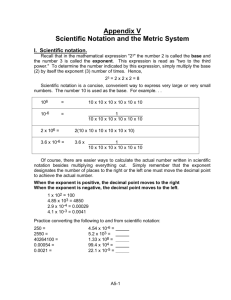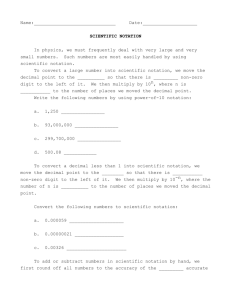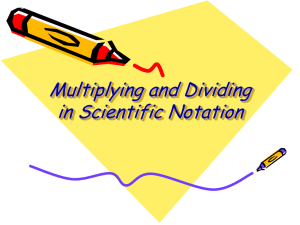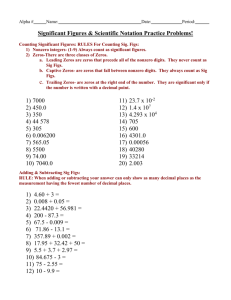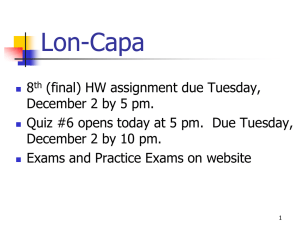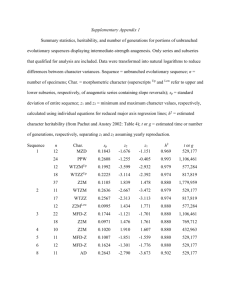Lab 1 - Metric system answers
advertisement
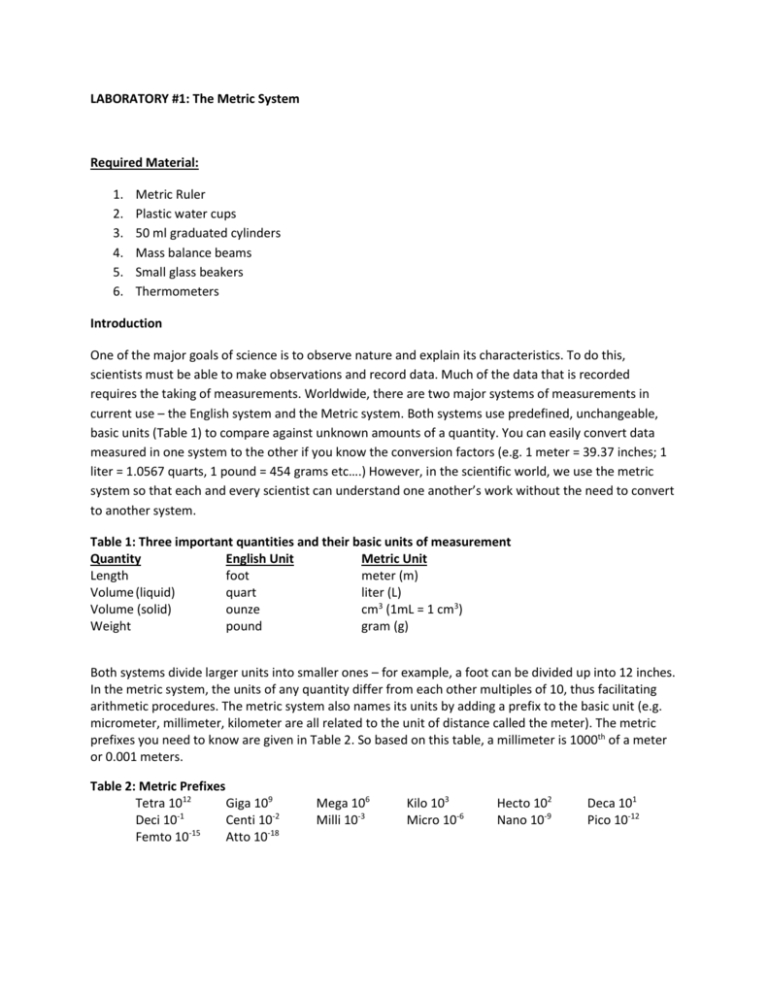
LABORATORY #1: The Metric System Required Material: 1. 2. 3. 4. 5. 6. Metric Ruler Plastic water cups 50 ml graduated cylinders Mass balance beams Small glass beakers Thermometers Introduction One of the major goals of science is to observe nature and explain its characteristics. To do this, scientists must be able to make observations and record data. Much of the data that is recorded requires the taking of measurements. Worldwide, there are two major systems of measurements in current use – the English system and the Metric system. Both systems use predefined, unchangeable, basic units (Table 1) to compare against unknown amounts of a quantity. You can easily convert data measured in one system to the other if you know the conversion factors (e.g. 1 meter = 39.37 inches; 1 liter = 1.0567 quarts, 1 pound = 454 grams etc….) However, in the scientific world, we use the metric system so that each and every scientist can understand one another’s work without the need to convert to another system. Table 1: Three important quantities and their basic units of measurement Quantity English Unit Metric Unit Length foot meter (m) Volume (liquid) quart liter (L) Volume (solid) ounze cm3 (1mL = 1 cm3) Weight pound gram (g) Both systems divide larger units into smaller ones – for example, a foot can be divided up into 12 inches. In the metric system, the units of any quantity differ from each other multiples of 10, thus facilitating arithmetic procedures. The metric system also names its units by adding a prefix to the basic unit (e.g. micrometer, millimeter, kilometer are all related to the unit of distance called the meter). The metric prefixes you need to know are given in Table 2. So based on this table, a millimeter is 1000th of a meter or 0.001 meters. Table 2: Metric Prefixes Tetra 1012 Giga 109 Deci 10-1 Centi 10-2 -15 Femto 10 Atto 10-18 Mega 106 Milli 10-3 Kilo 103 Micro 10-6 Hecto 102 Nano 10-9 Deca 101 Pico 10-12 The measurement of heat is also complicated by the existence of two different temperature scales. Both scales measure heat by measuring the amount of expansion and subsequent movement of mercury in a glass chamber in response to increase molecular motion due to the heat. This device is known as a thermometer. Thermometers are either calibrated to the Celsius scale or the Fahrenheit scale. The Celsius scale has 100 degrees between the freezing of water (0°C) and the boiling of water (100°C). The Fahrenheit scale has 180 degrees (32°F to 212°F). Since Fahrenheit degrees are 5/9th the Celsius scale, you can use the following equation for converting between these two systems Tc = 5/9(Tf-32) NOTE: Tc = temperature in Celsius; Tf = temperature in Farhenheit. In science, we frequently have to deal with very large or very small numbers. To simplify, we use scientific (exponential) notation. The rule is: C X 10n, where C is the coefficient - number between 1 & 10 and n is the exponent - a positive or negative integer (e.g. 1, -3), To find n, we count the number of places the decimal point must move to give the coefficient, C. If the decimal point moves to the right, n is a negative integer; if the decimal point moves to the left, n is a positive integer For example: 23.23 = 2.323 x 101 5609 = 5.609 x 103 0.0918 = 9.18 x 10-2 (101 = 10; 102 = 100; 103 = 1000 etc…..) To multiply in scientific notation, multiply the coefficients (C) and ADD the exponents (n). Be sure to write the final number is scientific notation also. e.g. (5.0 x 104) x (1.6 x 102) = (5.0x1.6) x 10(4+2) = 8.0x106 To divide, you subtract the exponents e.g. (6.01x10-3)/(5.23x10-6) = (6.01/5.23) x 10(-3-6) = 1.15x10-9 1. Measurements Investigators are concerned with accuracy and precision when measuring. Accuracy relates to how close a particular measurement is to the true value of the quantity. Precision is the degree of exactness with which a quantity is stated. Researchers express the degree of precision in significant figures by recording all figures they are certain of and one figure they are not. For example, if an object’s width is recorded as 10.345 mm, then the person measuring is sure of the 10.34 and unsure of the 0.005. Complete the following and report the values in conventional and scientific notation. A. Measure the width of your index fingernail in millimeters ____________ B. Collect a small rock from outside and measure its volume in milliliters by water displacement in a graduated cylinder ____________ C. Using a beam balance, determine the mass of the rock in milligrams. Using the rock’s mass and volume – calculate its density in g/L ____________ D. Measure and record the length and width of a microscope slide in centimeters ____________ E. Weigh an empty small beaker and record its weight in grams ____________ F. Using the graduated cylinder, pour 20 mL of water into the beaker and re-measure the beaker + the water. Calculate the weight of the water. How much would 1 mL of water weigh? ____________ G. Record the temperature of your water ____________ Worksheet Problems Answer the following in the spaces provided. Convert the following into decimals and then into scientific notation. Use two significant digits after the decimal point 1. 2. 3. 4. 5. 1/100 = 0.01 = 1.00 x 10-2 34/100 = 0.34 = 3.40 x 10-1 479/100 = 4.79 = 4.79 x 100 379/10,000 = 0.0379 = 3.79 x 10-2 267/100,000 = 0.00267 = 2.67 x 10-3 Convert the following into scientific notation. Use two significant digits after the decimal point 1. 2. 3. 4. 5. 6. 7. 8. 500 = 5.00 x 102 379 =3.79 x 102 14,890 =1.49 x 104 0.03 = 3.00 x 10-2 0.00345 = 3.45 x 10-3 0.0000000341 = 3.41 x 10-8 2 = 2.00 x 100 64 = 6.40 x 101 What do the following prefixes mean in relationship to the standard unit? a. b. c. d. Kilo- one thousand Centi- 1/100th Deci- 1/10th Milli – 1/1000th What do the following abbreviations mean? a. b. c. d. e. lb = pound g = gram cc = cubic centimeter mL = milliliter oz = ounze f. g. h. i. sec = second cm = centimeter L = liter km =kilometer Convert the following into decimal format numbers and then into scientific notation. Look at the units on the far right side to know what you are converting into! Use two significant digits after the decimal point 1. 2. 3. 4. 5. 6. 7. 8. 9. 10. 11. 12. 13. 14. 15. 16. 17. 18. 19. 20. 42 cm = 0.42 m = 4.20 x 10-1 m (centimeters to meters divide by a 100) 640 cm = 6.40 m = 6.40 x 100 m (cm to m divide by 100) 6 mm= 0.60 cm = 6.00 x 10-1 cm (mm to cm divide by 10) 598 mm = 5.98 cm = 5.98 x 10-2 cm (mm to cm divide by 10) 68 m = 0.068 km = 6.80 x 10-2 km (m to km divide by 1000) 54 m= 5400 cm = 5.40 x 103 cm (m to cm multiply by 100) 12 m = 12000 mm = 1.20 x 104 mm (m to mm multiply by 1000) 26 cm= 260000 um = 2.60 x 105 um (cm to um multiply by 10,000) 26 cm = 0.26 m = 2.60 x 10-1 m (cm to m divide by 10) 23 mL = 0.023 L = 2.30 x 10-2 L (mL to L divide by 1000) 345 L = 345,000,000 uL = 3.45 x 108 uL ( L to ul multiply by 1,000,000) 235 uL = 235,000,000pL = 2.35 x 108 pL (uL to pL multiple by 1,000,000) 6 um = 0.000006 m = 6.00 x 10-6 m (um to m divide by 10-6) 12 kg = 12000 g = 1.20 x 104 g (kg to g multiply by 1000) 6.2 ug = 0.0000000062 kg = 6.20 x 10-9 kg (ug to kg divide by 10-9) 2 ng = 0.000000002 g = 2.00 x 10-9 g (ng to g divide by 10-9) 50°F = 10°C = 1.0 x 101 °C 100°C = 212°F = 2.12 x 102°F 28 A° = 2.8nm = 2.8 x 10-9 m (nm to meter divide by 10-9) 567 A° = 56.7 nm = 5.67 x 101 nm Calculate the following. Use one significant digit after the decimal point 1. (5.0 x 104) x (1.6 x 102) = 8.0 x 106 (4 + 2) 2. (4.0 x 100)/(1.0 x 103) = 4.0 x 10-3 (0 – 3) 3. (9.0 x 109) x (2.0 x 105) = 1.8 x 1015 (9 + 5) 4. (6.0 x 104) x (6.0 x 10-4) = 3.6 x 101 (4 + -4) 5. (8.0 x 108) x (7.0 x 10-6) = 5.6 x 103 (8 + -6) 6. (6.0 x 10-2)/(5.0 x 10-8) = 1.2 x 106 (-2 - -8) 7. (6.0 x 103)/(3.0 x 10-2) = 2.0 x 105 (3 - -2) 8. (5.0 x 104) x (1.6 x 102) = 8.0 x 106 (4 + 2) 9. (8.0 x 10-3)/(2.0 x 10-6) = 4.0 x 103 (-3 - -6) 10. (10.5 x 10-2) x (5.0 x 10-4) = 5.25 x 10-5 (-2 + -4) A box measures 1cmx6cmx5cm. What is its volume? 30 cm3 Add 5.0 m + 6.25 m + 3.131 m = 14.381 m Add 1.2 g + 3 dg + 90 cg = 24 dg OR 2.4 g OR 240 cg


